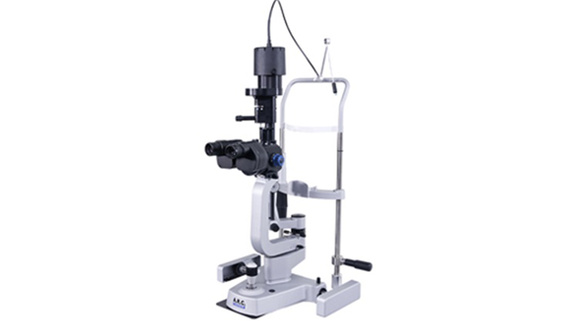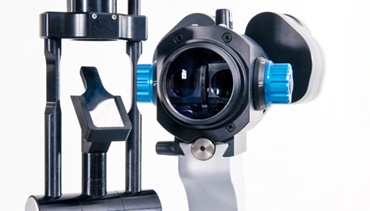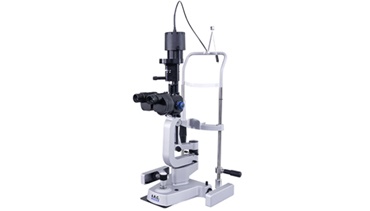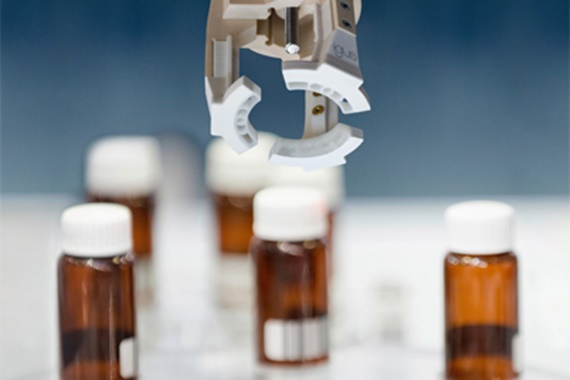Highly precise and maintenance-free bearing technology for slit lamps in ophthalmology
Plain bearings made of iglidur J agree on a simple movement with highest precision
A slit lamp allows the ophthalmologist to see the different parts of the eye with up to 40 times magnification. However, the technical requirements for the medical device are extremely high. It must not only be easy to move, but also to align with high precision. These "apparently" contradictory demands are solved today by means of iglidur J plain bearings, which are also used in many other medical fields. The self-lubricating bearings work reliably in the arm of the microscope over long periods of time despite constant stress.Profile
- What was needed: iglidur J plain bearing
- Requirements: highest precision, customised bearing shape, bearing for easy and silent running, hygienic use without additional lubricant, long service life
- Industry: Medical technology
- Success for the customer: The mechanical processing of the sleeve, especially the cutout for the cables, was very problematic as a brass part. With plastic, we were able to offer the customer a cost-effective solution. The plain bearings combine precision with smooth operation.
Discover all products for medical technology

Problem
The slit lamp is to the ophthalmologist what the drill is to a dentist. The microscope enables close examination of the various areas of the eye with up to 40 times magnification, thus facilitating a holistic diagnosis and the detection of various eye disorders. The technical requirements for the mechanical construction of the medical device are high. One critical issue is the movement of the microscope arm. It must be very easy to move the lamp, high-precision guides are required for the axes – because every irregularity and every unwanted motion is magnified 40-fold to the ophthalmologist through the microscope. Small adjustments in position are vital, however, when the ophthalmologist is searching for haemorrhages on the retina, for example. At the same time, he or she must also be able to securely fix the microscope arm.The slit lamps tested by medical technology manufacturer A.R. C. either prioritised ease of operation or precision. Operating both aspects was all the more difficult to achieve because the microscope is about 250 millimetres away from the bearing of the movable arm, forming a lever that makes precise and clearance-free bearing difficult.
In addition, it was also important that the plain bearing material is homogeneous so that the sliding properties are always the same even with machined components. Another important factor is silent motion and freedom from lubrication: ophthalmologists don't want to have to be greasing their equipment. Last but not least, service life is a central criterion because split lamps are often used all day, every day for decades.
Solution
In their search for the best possible bearing solution, the designers from A.R.C. came across the iglidur plain bearings. These bearings have already proven their worth in other areas of medical technology. When feed movements are performed, bearings with the standard E 10 fit are, as a rule, sufficient. In the case of A.R.C. slit lamp, significantly higher requirements had to be met. Here we are at the limits of what can be produced mechanically. Therefore, in close cooperation with A.R.C. a customised solution was worked out, which ensures the best possible fit with the smallest possible clearance while at the same time providing extremely smooth running and the possibility of fixing the setting. The material pairing was also adapted to this bearing solution.The plain bearings used are components made of iglidur J - the bearings supplied as bar stock are manufactured in the factory of A.R.C. which involves high precision tooling down to the nearest μm in order to obtain the desired fit. At the design stage, attention was paid to ensuring that the walls of the plastic plain bearings were as thin as possible in order to ensure the highest degree of dimensional stability. One factor that complicated matters was that A.R.C. makes openings in the bearing bushes to allow electrical cables to pass through the slit lamp arms.
A.R.C. also uses the plastic plain bearings at other bearing points of the slit lamp and is very satisfied with them. In combination with the used stainless steel and brass, perfect results are achieved here. The example impressively demonstrates that any reservations about the use of plastic bearings in medical technology are misplaced. On the contrary, these bearings make it possible to achieve the highest level of precision, being able to dispense with lubricants is very beneficial for reasons of hygiene. The intense endurance tests performed by A.R.C. over months also provide evidence of the long service life of the precision bearing on the microscope arm.
Thomas Herberger, designer at A.R. C.


Further application reports
Maintenance-free 3D-printed grippers
Plastic grippers from igus® filaments. They come directly from the 3D printing process. Since 2015, igus® has been offering tribologically optimised 3D print filaments for 3D printing. If the CAD data of a product are available, it would be easy to manufacture it in an additive process.
Now read an application report
3D printed bearing ready for collection within hours
What do you do when an important replacement part for an exhibit suddenly goes missing on the way to the trade fair? The response of the Berlin-based company Blackcam, a manufacturer of camera motion systems, is to turn to the igus® 3D printing service.
Now read an application report
Robust special bearing for hay swathers
FELLA has been designing implements for tractors for more than 90 years. These include mowers, hay rakes and swathers. The tractors have to withstand a lot of hard treatment in day-to-day work. igus® has produced especially robust special parts for FELLA.
Now read an application report



